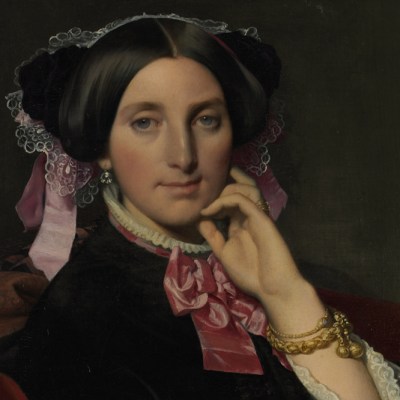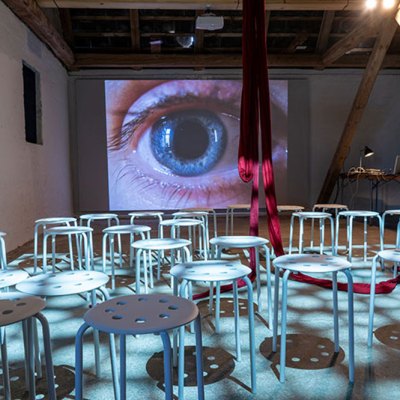From the September 2023 issue of Apollo. Preview and subscribe here.
Ingres was the ultimate perfectionist, meditating for years over his choices, and continually revisiting compositions with the benefit and discomfort of hindsight. This exhibition at Chantilly plunges the visitor into the heart of the painter’s creative process. The Musée Condé possesses no fewer than five major works by Ingres, which testify to his versatility in addressing different genres and audiences. Through juxtaposition with preparatory drawings and alternative takes on the same subject, this exhibition uses these works to explore the artist’s obsessive revisionism. In returning to pictures sometimes several decades later, as in the case of the Venus Anadyomene – first planned in 1807, reworked in 1822, but only finished in 1848 – Ingres settled old scores and rewrote the story of his artistic career.
The large space of the Jeu de Paume room is divided into sections, each dedicated to a specific cluster of works. Striking the visitor upon entrance is a gem of the Chantilly collection, the painter’s self-portrait, a dramatic statement of his vocation. The confidence of this composition, with its nod to Raphael, intense stare, sombre palette and Mediterranean good looks, belies the fact it had changed radically since its appearance in the Salon of 1806, when the critics had torn it apart. The most faithful clue to what the critics actually saw that year comes in a copy made by the artist’s then fiancée Julie Forestier, which depicts him not just rubbing the canvas, left arm outstretched, but also with a huge grey coat slung over his right shoulder. It was this virtuoso passage Ingres found superfluous when he reworked the picture in the years after 1850, creating a more self-contained image of his younger self for posterity. Comparisons with a photograph taken by Charles Marville, as well as new technical analysis, suggests the mystery of the portrait’s genesis and modifications might at last be solved.
As a portraitist, Ingres is sans pareil, and in Madame Duvaucey, a product of his Roman period, we admire his harmonious blend of soft, rounded forms and exquisite material details New research by Nicole Garnier-Pelle has corrected the painter’s belief that Duvaucey was the wife of French ambassador to the Holy See, Alquier – she was in fact his Neapolitan mistress, being married to an infantry captain named Duvaucey – and revealed new details about his relationship with the couple, who had an illegitimate son. Since David’s portrait of him was destroyed, Alquier is represented in the show by Wicar, whose portrait underlines the ambassador’s devotion to the French state. After his death Madame Duvaucey was reduced to penury, and Ingres intervened to help her sell the painting. It was ultimately bought by the connoisseur Frédéric Reiset, from whom the duc d’Aumale acquired it, along with two other works by Ingres, in 1879.
Portrait of Madame Duvaucey (1807), Jean-Auguste-Dominique Ingres. Musée Condé, Chantilly. Photo: © RMN-Grand Palais Domaine du Chantilly/Adrien Didierjean

Another feature of Ingres’ apprenticeship in Rome, namely his fascination with the quattrocento, is explored thanks to multiple iterations of Paolo and Francesca, the doomed lovers from the Divine Comedy. Now cleaned, the austerity and concision of the version kept at Chantilly is immediately apparent, especially when compared to rival interpretations, like that by Coupin de la Couperie hanging nearby, a riot of medieval decor and incipient melodrama. The richly coloured variant in tondo loaned from Glen Falls is particularly swooning, with the book that has fallen from Francesca’s grasp upon Paolo’s kiss still suspended in mid air.
The exhibition illuminates the artist’s relations with the Orléans family, starting with Ferdinand, the eldest son of Louis-Philippe, whose patronage of the arts was celebrated at an exhibition at Montauban in 2021. If the first work by Ingres acquired by Ferdinand was Oedipus and the Sphinx in 1829 – represented here in contrasting versions – the first he commissioned was Antiochus and Stratonice (1840), a tale of illicit desire from the ancient world. The controlled theatricality of the final work is thrilling, as befits a story lifted from an opera by Méhul, as is the stark geometry of its classical interior (supplied by the trainee architect Baltard). The contorted and shadowy male figures contrast with the spotlit figure of Stratonice herself, whose contemplative pose is knowingly reproduced in the Frick’s famous portrait of Louise de Broglie at the end of the exhibition. In a luminous drawing from 1866, Ingres inverted the composition and muted the palette to invest the same story with a very different mood.
Paolo and Francesca (1814), Jean-Auguste-Dominique Ingres. Musée Condé, Chantilly. Photo: © RMN-Grand Palais Domaine du Chantilly/Adrien Didierjean

Ferdinand’s death in a freak carriage accident in 1842 ensured that the portrait of the heir to the throne, painted by Ingres just months earlier, and displayed here in three iterations, became an icon of national mourning. Ingres designed the windows for the chapel built at the spot where Ferdinand fell in Neuilly, in which the saints bear the likenesses of the grieving Orléans family, and later for the necropolis at Dreux. Louis-Philippe’s youngest son, the duc d’Aumale, wanted Ingres for a similar commemorative chapel that he intended for Chantilly. Interrupted by the 1848 revolution, Aumale instead translated the chapel idea first to Twickenham and then ultimately to his country house at Wood Norton, for which the windows were created by Mottez, a pupil of Ingres. Aumale’s brother Montpensier, meanwhile, turned in 1844 to Ingres for a radically reduced variant of his painting of Virgil reciting the Aeneid to Augustus (borrowed here from Brussels). In contrast to the original work from 1819, this later version is reminiscent of a solemn pièta, as Ingres dispensed with Virgil altogether and foregrounded instead the unconscious, beatific figure of Octavia, who has fainted upon an allusion to the death of her son.
This is a scintillating exhibition about the artist’s obsessive working methods, his princely patrons and the recurrent preoccupations that knit together works from across his whole career. Its success hinges on the quality of the loans, which are indeed superlative, thanks to the support of institutions such as the Musée d’Orsay and the Frick, alongside a corpus of drawings from Montauban. Built upon the latest research, this elegant show is a sensual delight.
Ingres: The Artist and his Princes is at the Musée Conde, Chantilly, until 1 October.
From the September 2023 issue of Apollo. Preview and subscribe here.



